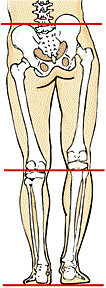Can Custom Foot Orthotics or “Scoliosis Insoles” Reverse Scoliosis?
“Orthotics”, “foot orthoses”, “orthotic devices” or “biomechanical orthotic devices” are prescribed, custom-made devices that alter the motion and change the pressure on the weight-bearing surface of your foot. They allow for normal motion but limit abnormal motion. They can be prescribed to help correct problems such as: excessive pronation, low arches, cavus, high arches and painful feet. They are also prescribed to follow some foot surgeries to help keep correction achieved with surgery.
By altering the heel height custom orthoses can also be used to correct or reduce short leg or what is known as a leg length inequality. This can be an underlying cause of acceleration of scoliosis in some patients.

The fit and style of the shoe can affect the functioning of the orthotic device. Shoes should have 1/4 inch to 1/2 inch space between the end of your longest toes and the end of the toe box. The toe box should be wide enough side-to-side to accommodate all of your toes without pressure. The instep should be of sufficient height to not cause abnormal pressure at the ball of the foot. The heel counter should be firm and high enough to accommodate the orthoses. The heel counter should either be straighter or curved, depending on your particular foot type. Trying to fit a pronated foot type into a very curved-lasted shoe causes abnormal pressure on the small toe side of your foot.
Foot orthotic are frequently used to treat a variety of conditions of the foot and ankle.
- aligning and supporting the foot or ankle
- preventing, correcting or accommodating foot deformities
- improving the overall function of the foot or ankle
The type of orthosis recommended by your doctor will depend on your symptoms, the underlying cause for those symptoms, and the shape of your feet. A wedge inserted into the inner (medial) side of the sole of a shoe can be used to help support a flatfoot, thus reducing the risk of tendinitis. An ankle-foot brace can help relieve the pain of rheumatoid arthritis in the heel or ankle. A heel flare can be used to increase support and help prevent ankle sprains. Heel cushions can help absorb impact and relieve stress on the heel and ankle when you walk or run.
In the past, plaster molds of the foot were used to construct the custom-made orthosis. Today, computerized foot analysis is often used to develop orthoses that more accurately reflect the dynamics of your gait. Unlike generic, over-the-counter orthotics, Stabilizing Orthotics are individually designed for unique postural problems — not just problems with your feet. Correcting imbalances in your feet can properly align your spine and pelvis. Although custom orthoses are considerably more expensive than off-the-shelf devices, they last much longer and provide more support or correction.
Orthotics for Scoliosis

Foot Orthotics to Prevent Scoliosis
Nonstructural or functional scoliosis, is a curve in the spine, without rotation, that is reversible because it is caused by a pain, a muscle spasm or a difference in leg length. Compensatory scoliosis, is a spinal curve in the coronal plane which disappears when the patient sits. It also may be caused by either a short leg or a pelvic tilt due to contracture of the hip.
Scoliosis most commonly presents in children during the growth spurt that precedes puberty. An asymmetrical leg growth could result in an imbalanced spinal growth. Using a heel lift — a wedge-shaped shoe insert — in the shoe of the shorter leg can add extra support and promote a more balanced spinal growth. However, if one leg is shorter because the foot has poor arch development or because the child places excess weight on the inside of one sole, they may require a custom orthotic to support the foot in the areas around the arch. If the leg is functionally rather than anatomically shorter, the scoliosis may worsen if a heel lift is used rather than an orthotic shoe insert.

Research on Foot Orthotics
An article published in a 2001 issue of European Spine Journal, showed adolescent patients with scoliosis had significantly reduced spinal curvature and improved postural adaptations (e.g. better pelvis alignment) after wearing shoe lifts. Orthopedic shoes and custom foot orthotics may prevent further progression of certain types of scoliosis in children with asymmetrical legs and reduce back pain in adults with scoliosis. However, according to an article in The New York Times Health Guide, whether heel lifts can reduce existing spine curvature is still to be determined. More research remains to be done to clarify the use and appropriation of orthotics in scoliosis. By taking an X-ray with the orthotic in place, it can be determined how the orthotic is effecting the scoliotic spine.
Caution!
Though many stores offer over-the-counter orthopedic shoes, orthotic inserts and heel lifts, these are not custom designed, which means they are ineffective for an individual with an abnormal spinal curvature. Because of this they could even make scoliosis worse or create other orthopedic problems if they don’t fit properly.
Orthopedic shoes and foot orthotics can be just one aspect of a comprehensive program of treatment for an individual with scoliosis or for those at risk of developing scoliosis. It is important to see a scoliosis specialist for a full scoliosis assessment and evaluation of the lower extremities. Depending on the type and severity of scoliosis, exercise-based program for scoliosis may be the best treatment for scoliosis.

